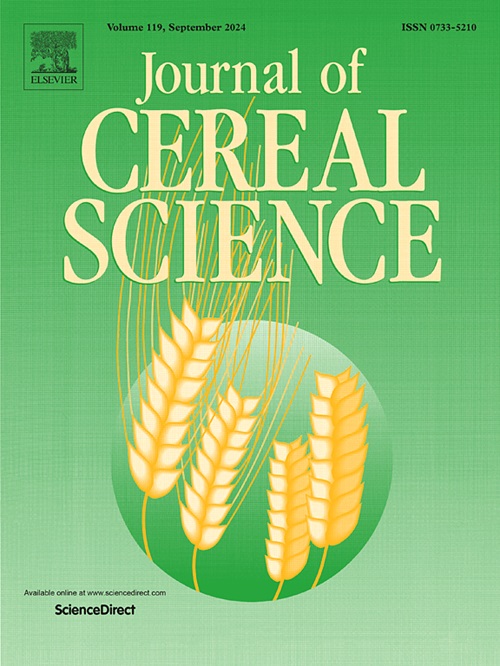Molecular and functional consequences of drying on edible dock powder: Impacts on wheat protein interactions, steamed bun properties, and simulated digestion enzyme inhibition
IF 3.7
2区 农林科学
Q2 FOOD SCIENCE & TECHNOLOGY
引用次数: 0
Abstract
Edible dock, a protein-rich perennial interspecific hybrid Rumex with hypoglycemic potential, is increasingly used in wheat-based products as dock powder (DP). This study investigated the impact of different drying methods (50 °C/80 °C air-drying, freeze-drying) on DP composition, dough properties, steamed bun quality, and post-digestion bioactivity, aiming to optimize DP drying and application for glycemic control. Freeze-dried DP (DPFD) best preserved dietary fiber, phenolics, and flavonoids, while 80 °C air-drying (DP80) improved bun textural properties. DPFD dough exhibited greater stability despite a shorter development time. Sensory evaluation favored 5 % DP80-added bun, though DP generally lowered taste/flavor scores. Microstructure analysis revealed gluten network disruption in DP-added doughs, correlating with uneven air cell distribution in buns. SDS-PAGE indicated that low temperature-drying preserved Rubisco large subunits, whereas 80°C-drying promoted gluten protein cross-linking. In vitro digestion studies showed that both DP and DP-added buns inhibited α-amylase and α-glucosidase. Critically, intestinal digesta from DPFD-added buns showed enhanced α-glucosidase inhibition, strongly correlated with retained flavonoids. These findings demonstrate that drying methods significantly impact DP's functional properties and its effect on post-digestion glycemic responses in wheat products. This suggests that carefully selected drying methods can optimize DP application to create healthier, functional wheat products with improved glycemic control potential.

干燥对食用船坞粉的分子和功能影响:对小麦蛋白质相互作用、馒头特性和模拟消化酶抑制的影响
食用船坞是一种富含蛋白质的多年生种间杂交种,具有降糖潜能,作为船坞粉(DP)在小麦制品中的应用越来越广泛。本研究考察了不同干燥方法(50℃/80℃风干、冷冻干燥)对DP组成、面团性质、馒头品质和消化后生物活性的影响,旨在优化DP的干燥方法及其在血糖控制方面的应用。冻干DP (DPFD)能更好地保存膳食纤维、酚类物质和类黄酮,而80℃风干(DP80)能改善面包的织构特性。DPFD面团在较短的发育时间内表现出较好的稳定性。感官评价倾向于添加5% dp80的面包,尽管DP通常会降低味道/风味评分。微观结构分析表明,添加dp的面团面筋网络被破坏,这与面团内空气细胞分布不均匀有关。SDS-PAGE表明,低温干燥保存了Rubisco大亚基,而80℃干燥促进了面筋蛋白的交联。体外消化研究表明,添加DP和DP的馒头对α-淀粉酶和α-葡萄糖苷酶均有抑制作用。重要的是,添加dpfd的小圆面包的肠道食糜表现出增强的α-葡萄糖苷酶抑制,这与黄酮类化合物的保留密切相关。这些结果表明,干燥方法显著影响小麦产品中DP的功能特性及其对消化后血糖反应的影响。这表明,精心选择干燥方法可以优化DP的应用,从而生产出更健康、功能更强、血糖控制潜力更强的小麦产品。
本文章由计算机程序翻译,如有差异,请以英文原文为准。
求助全文
约1分钟内获得全文
求助全文
来源期刊

Journal of Cereal Science
工程技术-食品科技
CiteScore
7.80
自引率
2.60%
发文量
163
审稿时长
38 days
期刊介绍:
The Journal of Cereal Science was established in 1983 to provide an International forum for the publication of original research papers of high standing covering all aspects of cereal science related to the functional and nutritional quality of cereal grains (true cereals - members of the Poaceae family and starchy pseudocereals - members of the Amaranthaceae, Chenopodiaceae and Polygonaceae families) and their products, in relation to the cereals used. The journal also publishes concise and critical review articles appraising the status and future directions of specific areas of cereal science and short communications that present news of important advances in research. The journal aims at topicality and at providing comprehensive coverage of progress in the field.
 求助内容:
求助内容: 应助结果提醒方式:
应助结果提醒方式:


